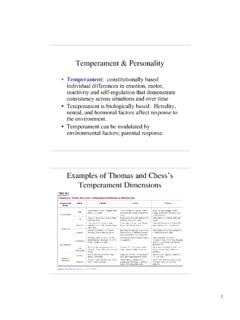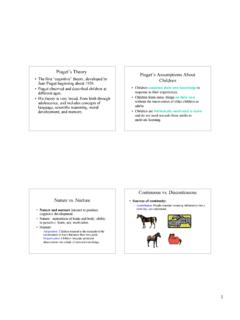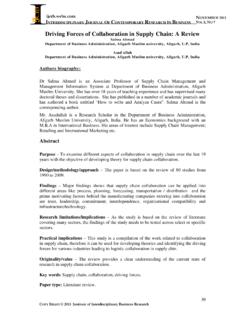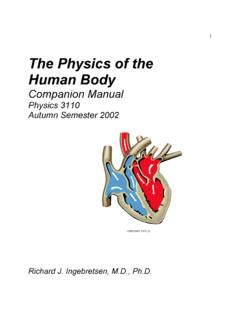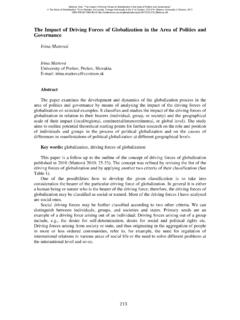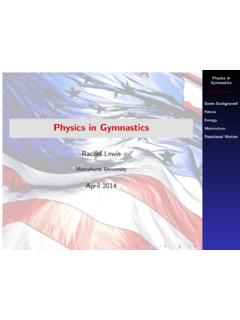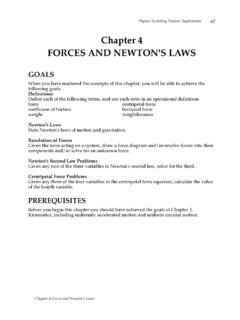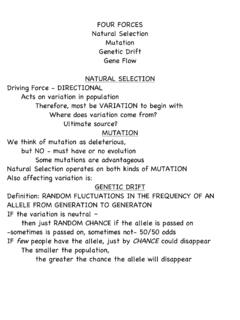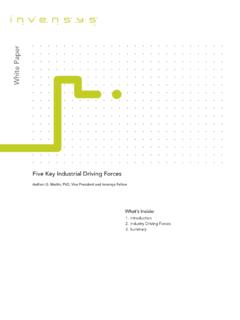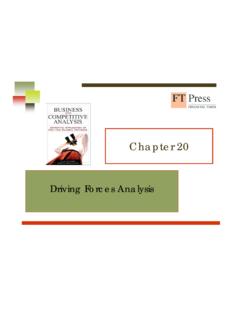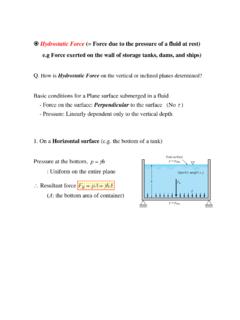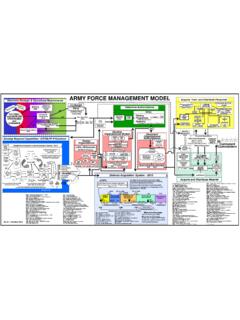Transcription of Chapter 13: The Five Forces Behind Human Evolution
1 1998, 1999, 2000 Gregory CareyChapter 13: five Forces - 1 Chapter 13: The five Forces Behind Human EvolutionIntroductionFive different Forces have influenced Human Evolution : natural selection, randomgenetic drift, mutation, population mating structure, and culture. All evolutionary biologistsagree on the first three of these Forces , although there have been disputes at times about therelative importance of each force . The fourth and fifth Forces are new in the sense that theyare not explicated in more traditional texts. This is not an attempt to develop a new theory of Human Evolution . Instead, the Forces of population mating structure and cultureare arbitrary categorizations used to organize several different phenomena of humanevolution. Scientists agree on the phenomena themselves, although they do not alwaysorganize them the same of the five Forces will be explained in turn.
2 This is a risky approach because itcan lead to the false impression that the five operate quite distinctly and differently fromeach other. In fact there are important interactions among these Forces , a topic that will bediscussed at the end of this SelectionNatural selection is defined as the differential reproduction of organisms as afunction of heritable traits that influence adaptation to the environment. There are threeessential components to this definition (1) differential reproduction, (2) heritable traits,and (3) adaptation to the noted that most species reproduce at a rate that, if unchecked, would lead toexponential population growth. However, such growth is seldom realized in nature becausemany organisms fail to reproduce. Darwin reasoned that if this differential reproductionwas associated with adaptation to an environmental niche and if the adaptive traits were 1998, 1999, 2000 Gregory CareyChapter 13: five Forces - 2transmitted to a subsequent generation, then the physical and behavioral traits of a specieswill change over time in the direction of better variation fuels natural selection and genetic inheritance transmits adaptivetraits from one generation to the next.
3 If all the members of a species were geneticallyidentical, then there would be no genetic variation and hence no natural selection. Theorganisms in this species could still differentially reproduce as a function of theiradaptation, but they would transmit the same genes as those who failed to index natural selection by reproductive fitness, often abbreviated as justfitness. Reproductive fitness can be measured in one of two ways. Absolute reproductivefitness may be defined as the raw number of gene copies or raw number of offspringtransmitted to the subsequent generation. It may be expressed in terms of individuals ( ,George has three children), phenotypes ( , on average the red colored birds produce ), or genotypes ( , on average genotype Aa has offspring). For sexuallyreproducing diploid1 species like us humans, a convenient way to calculate absolute fitnessis to count the number of children and divide by 2.
4 For example, someone with 2 childrenwould have an absolute fitness of , indicating that the person has left one copy of eachallele to the next second way of measuring reproductive fitness is relative reproductive fitness is simply the absolute fitness of an individual, phenotype, or genotypedivided by the absolute fitness of a reference individual, phenotype, or genotype. Forexample, suppose that the absolute finesses of genotypes aa, Aa, and AA are , , and If AA is the reference genotype, then the relative fitness of aa is =.72, the relative fitness of Aa is = .96, and the relative fitness of AA is = is customary, but not necessary; to express the relative fitness of genotypes in terms ofthe most fit genotype. 1998, 1999, 2000 Gregory CareyChapter 13: five Forces - 3It is crucial to distinguish reproductive fitness from desirability.
5 The fastest, themost agile, the longest-lived, and the most intelligent do not need to be the fittest in areproductive sense. Fitness is defined solely and exclusively in terms of gene copies left tothe subsequent generations. There is no mention of social values in this definition. Agenotype that promotes longevity is more fit than one leading to a shorter lifespan only if itleaves more copies of , fitness is correlated with survival but it is not synonymous with , popular culture has equated natural selection with the term survival of thefittest,2 implying a tooth and claw struggle in the jungle. Natural selection often involvessubtle mechanisms, some of which may actually end in the organism s death! After aperilous journey from salt water to the headwaters of a stream, salmon reproduce and thendie. The male preying mantis is literally devoured by the female while in the very act important part of fitness and natural selection is competition with otherconspecifics (other members of the same species).
6 The environment for an organism ismuch more than physical surroundings. It also includes the behavior of , reproductive fitness for many organisms is defined less in terms of their physicalcapacity to reproduce and more in terms of being able to outreproduce other male gorilla, for example, can survive, be healthy, and be physiologically capable ofproducing many offspring. His main problem with reproductive fitness lies with othermales. Unless he can entice fertile females away from an established male, his reproductivefitness will be low. 1 Diploid refers to a species that has two gene copies in its genome. Some plants are tetraploid, meaningthat they have four gene The philosopher Herbert Spencer coined the actual term not by Charles Darwin.
7 1998, 1999, 2000 Gregory CareyChapter 13: five Forces - 4 The Three Modes of Natural SelectionFor continuous traits, there are three modes of natural selection directional,stabilizing, and disruptive. In directional selection, fitness increases with trait value. Anexample of directional selection is presented in Figure [Insert Figure about here]Here, the phenotype has a normal distribution (solid blue line). The dashed red linegives the fitness function (aka selection function) and the relative fitness is expressed on theright hand vertical scale. Fitness is lower for low values of the phenotype and becomesprogressively larger for larger phenotypic values. After several generations of selection, themean of the distribution will shift towards the right, in the direction of increased Human evolutionists suspect that Human brain size underwent directionalselection.
8 About 4 million years ago (mya), the brain size of our probable ancestors, theAustralopithecines, was around 450 cc (cubic centimeters), only slightly larger than that of acontemporary chimpanzee. Around 2 mya, brain size almost doubled with the emergence ofHomo Habilis and later Homo Erectus. Brain size increased so that modern humansaverage between 1300 and 1400 second mode of natural selection is stabilizing selection. Here, trait values thatare close to average have the highest fitness and fitness decreases as one moves away fromthe mean (Figure ). In the popular mind, natural selection is almost always equatedwith directional selection. Yet most biologists suspect that stabilizing selection is the mostfrequent mode of natural selection. Most species are well adapted to their ecologicalniches otherwise, they would have gone extinct many eons ago so being somewherearound the average is more likely to be beneficial than having an extreme selection will not change the mean of a distribution but it may reduce the geneticvariance over time.
9 [Insert Figure about here] 1998, 1999, 2000 Gregory CareyChapter 13: five Forces - 5 Human birth weight is a classic example of stabilizing selection. Before modernmedical interventions, low birth weight neonates had high mortality. Similarly, neonatesmuch larger than average posed serious problems for their mothers and themselves. Interms of infant survival, it was preferable to be near the mean rather than at the third mode of natural selection is disruptive selection (Figure ). Herephenotypes close to the average have reduced fitness compared to phenotypes at theextremes. Disruptive selection appears to be the rarest form of natural selection and,indeed, there are few well-documented cases of it. There does not appear to be a goodexample of disruptive selection in Human Evolution . Despite its rarity, however,disruptive selection may be very important for the emergence of species.
10 After suitabletime, disruptive selection can lead to bimodal distributions that might eventually lead todifferent species.[Insert Figure about here]The Effect of Natural SelectionThe ultimate effect of natural selection is to change allele frequencies. It operatesonly on what is already present in the genome of a species and makes some alleles (andcombinations of alleles) more frequent and other less frequent. Nevertheless, theappearance, anatomy, and physiology of a species may change over time simply becausesome alleles become rare after lengthy natural selection. Programs in artificial selectionwhere humans control the selection process are the best illustrations of the tremendousgenetic variability hidden in a species genome. All contemporary strains of dogs had theirorigin in the wolf. The fact that dogs come in all sizes (from chihuahua to wolfhounds),color patterns (Dalmatians to golden retrievers), and temperaments (high strung terriers to 1998, 1999, 2000 Gregory CareyChapter 13: five Forces - 6phlegmatic basset hounds) is due to deliberate selection of rare allelic combinations in thewolf genome3.






